Cell phone coverage maps: who has the best network in America?
We've found the cell phone coverage maps for all the major cell providers in the US, to help you find the best option for your local area.
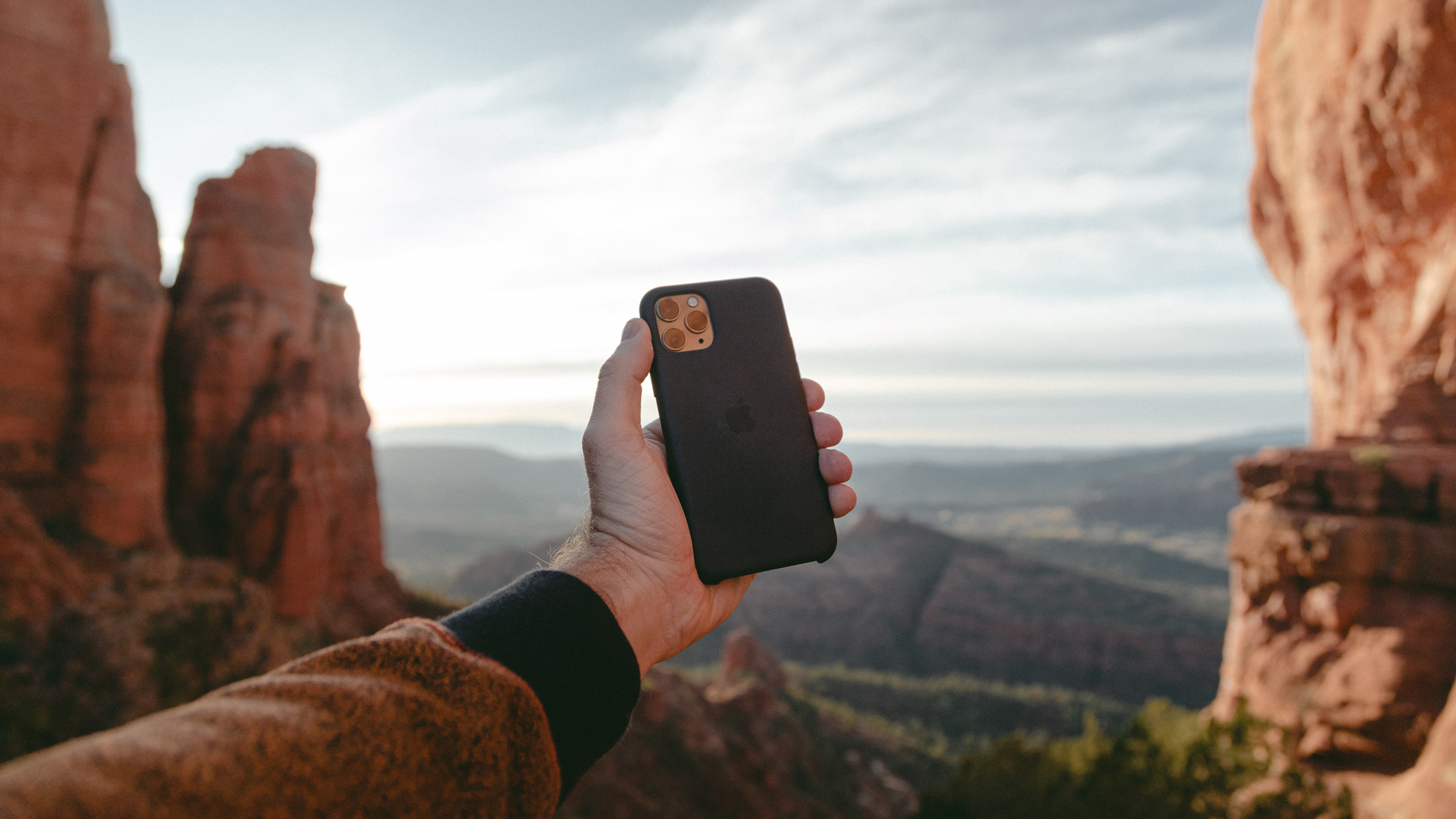
Cell phone coverage maps are really useful tools that help you figure out what type of cell phone coverage you get in your local area. There are plenty of cell phone companies out there competing for your custom when it comes to phone networks, with the big names like Verizon, AT&T, and T-Mobile alongside smaller networks like Mint Mobile and Visible which are looking to make a name for themselves.
These companies are always offering amazing deals and bragging about their ultra fast download speeds, but it can be difficult to tell if you’ll actually get those speeds where you live?
Fortunately, all of the best cell phone providers have cell phone coverage maps and ZIP code/address checkers that can help you see exactly what kind of service you’ll get at your location. We’ve done some digging and checked out all of these coverage maps to see just how extensive each of these cell phone networks is. We’ve also got links to all the individual coverage maps so you can compare each network and find the best choice for your area.
Verizon Wireless
Verizon Wireless is our top ranked choice when it comes to cell phone plan providers thanks largely due to its excellent network coverage and speed. With that said, there are some rural and remote areas that Verizon’s coverage doesn’t stretch to. Thankfully, the Verizon coverage map lets you check the coverage in your area (or anywhere else in the USA). This map comes with a legend that differentiates between 5G ultra wideband, 5G, 4G LTE, and 3G coverage so you’ll be able to see exactly what kind of coverage you can expect in your local area. You can also enter your ZIP code or address into the search bar.
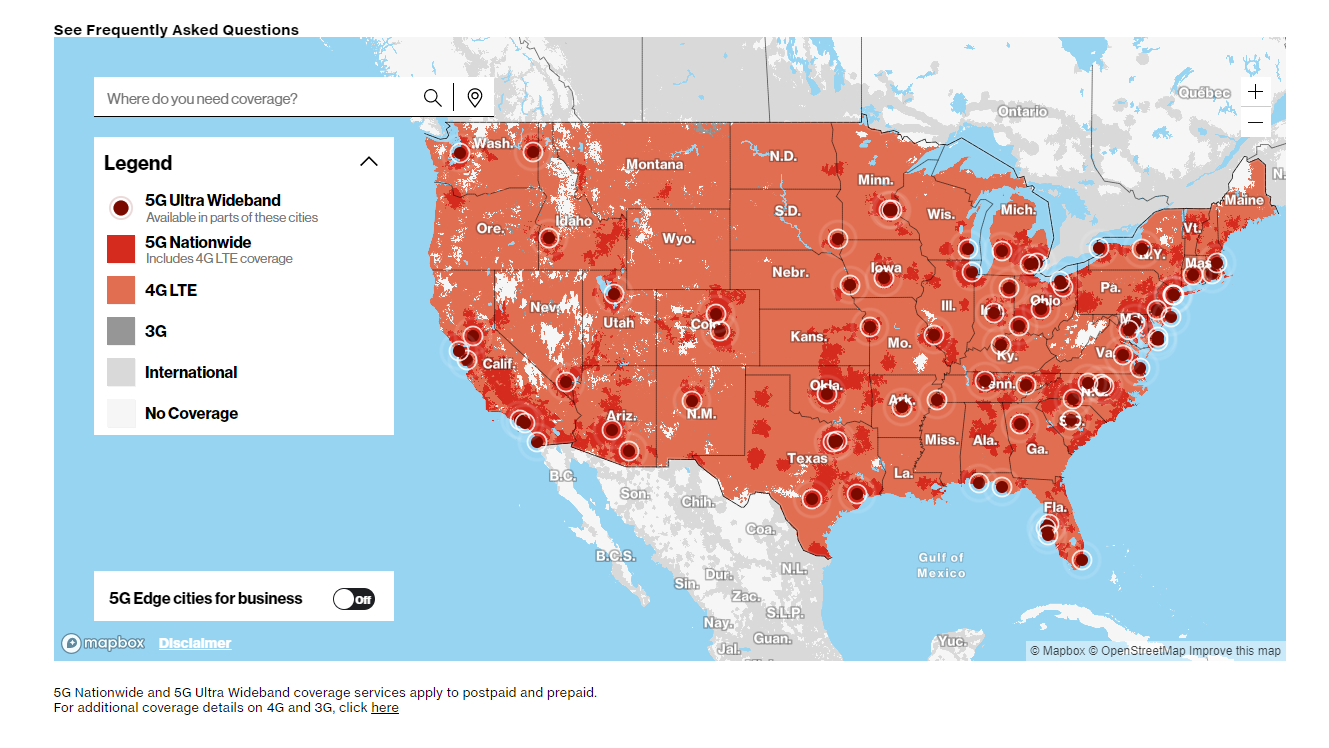
As you can see from the coverage map above, Verizon’s 4G LTE network has the vast majority of the United States covered, including Hawaii and the most populated areas of Alaska. In fact, Verizon claims to cover more than 99% of the population, so unless you live with bears on a mountain in the Rockies, chances are good that Verizon has you covered. There are some visible gaps in the Midwest and West Coast, but coverage in the East is incredibly good.
5G ultra wideband is Verizon’s super-fast 5G network. It uses a high-band, ultra-wide millimeter wave spectrum to deliver faster speeds and lower latency than even regular 5G. At the moment, this service is only available in select cities across the country.
AT&T
AT&T’s network has seen a huge upgrade since the last time we looked at its coverage, with a vast expansion of its 5G coverage in particular. The updated version of the AT&T interactive coverage map now shows areas of 5G+ (symbol), 5G (light blue), 4G LTE (dark blue), other AT&T coverage (green), and off-network coverage (yellow). You’ll need to zoom in on the map to see the detailed breakdown of network coverage though. You can also enter your ZIP code or address into the search bar for a quick check of your location.
Sign up to receive the latest news, reviews, buying guides and deals direct to your inbox
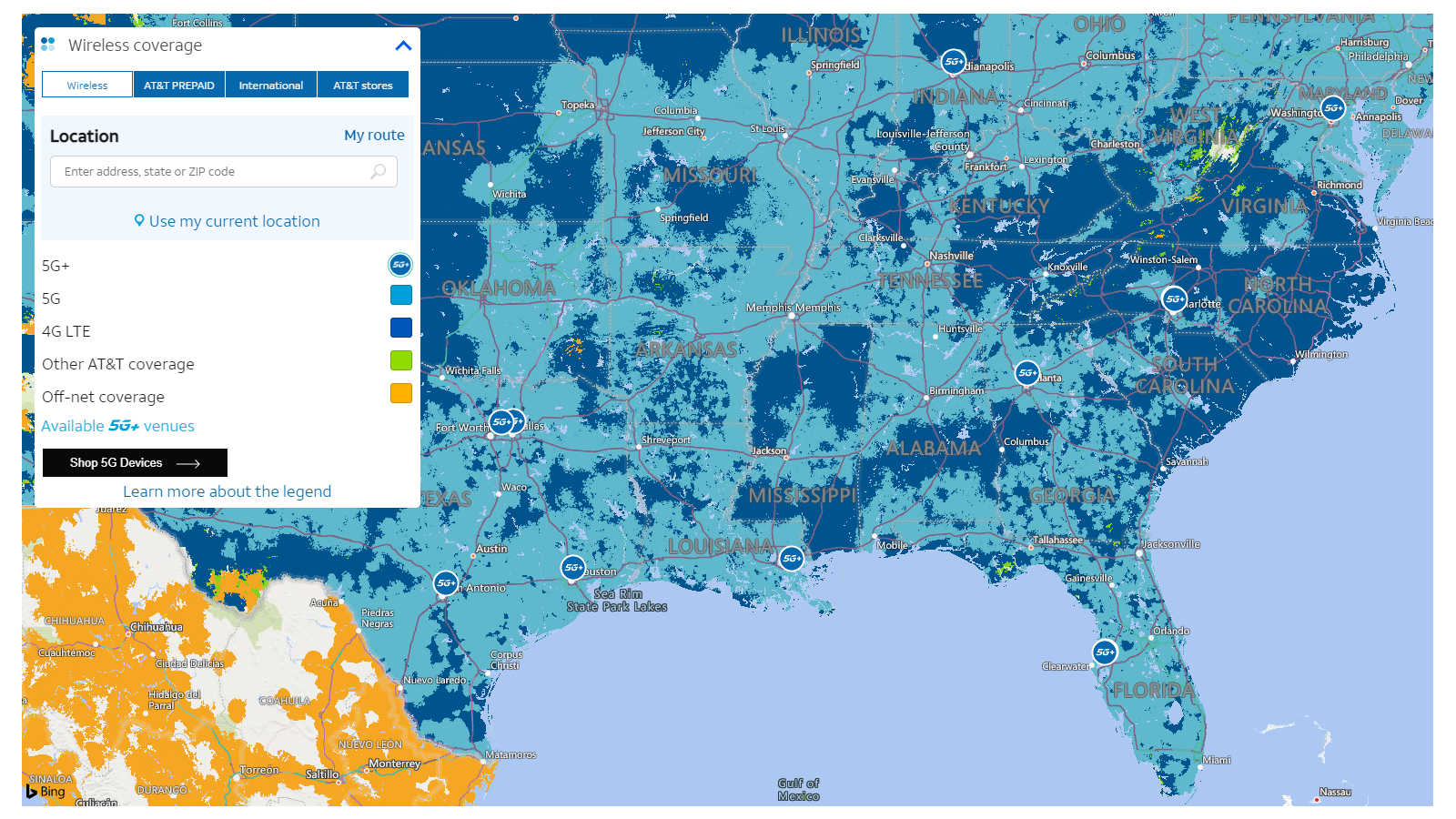
This granular data means that you’ll be able to tell exactly what kind of service you can expect in your area. 5G+ is only available in a handful of major cities, but the regular 5G coverage is impressive to look at, with AT&T stating that its 5G network now reaches over 14,000 cities and towns.
Depending on your plan, AT&T says that “Excessive use of off-net service may result in the loss of coverage in such areas as stated in your plan terms”. There is also a warning that off-net coverage may be limited to 2G speeds. So, if you live in one of the yellow areas of the map, you may want to consider another provider.
T-Mobile
Since the merger of Sprint and T-Mobile back in 2020, T-Mobile now has the largest 5G network in America. And if we’re honest, T-Mobile was already winning the 5G coverage competition long before that too, so it is probably your best bet if you’re looking for those sweet 5G download speeds. At the same time, it also covers 99% of Americans with its 4G LTE network, so you’re almost certainly going to be covered. You can see the network’s full coverage by checking out the T-Mobile interactive coverage map.
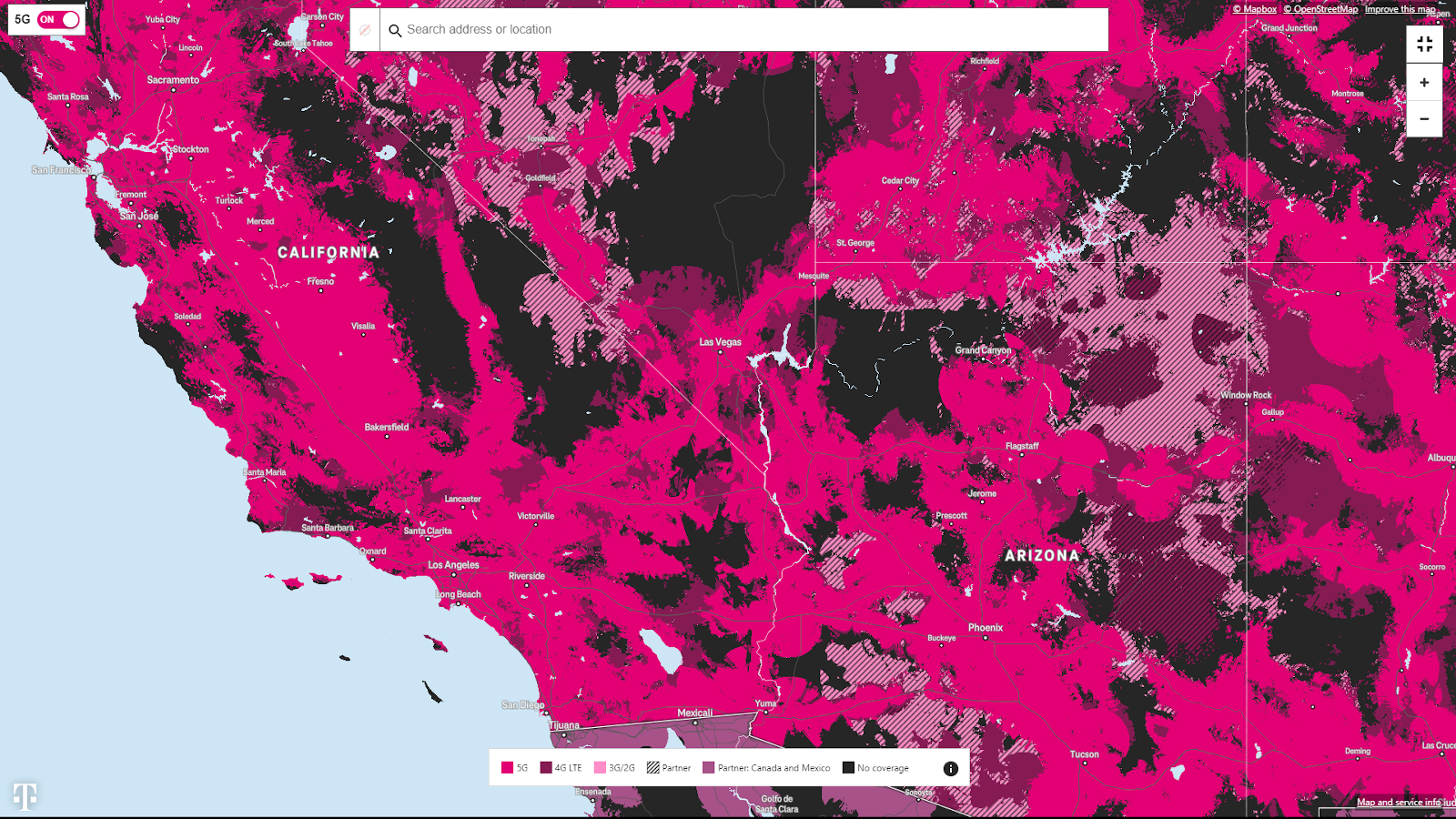
Again, you’ll need to zoom in to see the detailed breakdown of coverage, but there is impressive granularity here so you’ll be able to tell exactly what coverage you get in your hometown. The map shows 5G (bright pink), 4G LTE (purple), 3G/2G (light pink), partner coverage (lilac), and no coverage (black). T-Mobile has really committed to that pink color branding so those differentiations might not be clear on reading, but you can clearly see the differences on the map itself. You can also enter your ZIP code or address into the search bar to find coverage at your exact location.
US Cellular
Outside of the big three, US Cellular is the only other cell phone provider that actually uses its own network. The US Cellular coverage map looks very impressive at first glance, but zooming in reveals that huge portions of the network are actually partner coverage, which basically means you’ll be jumping onto another network like Verizon, AT&T, or T-Mobile in these areas.
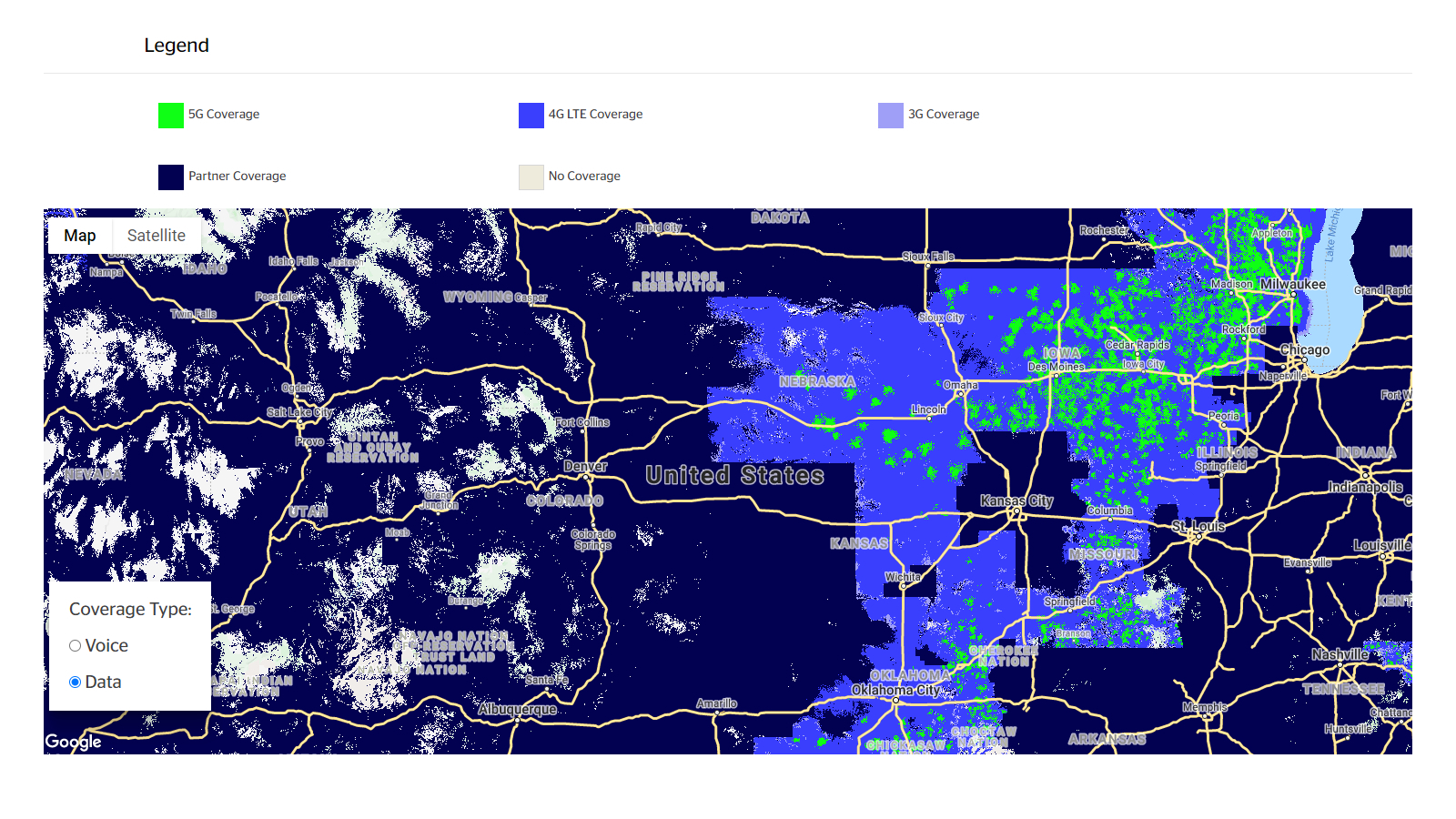
US Cellular’s own network primarily covers Iowa, Nebraska, Wisconsin, Kansas, Oklahoma, Oregon, Washington, North Carolina, Maine, and New Hampshire. US Cellular’s 5G coverage is rather limited compared to the other major networks though, and can only really be found in those states.
You can see the full US Cellular coverage map over at the company’s website. You’ll need to zoom in to get the full breakdown of coverage types, with 5G (green), 4G LTE (blue), 3G (light blue), and partner coverage (dark blue). You can also enter your ZIP code or address into the search bar.
Mint Mobile
Mint Mobile uses the T-Mobile network to provide its cell coverage. However, this doesn’t just mean that you can use the T-Mobile coverage map to check on your Mint coverage, as that map includes partner coverage for T-Mobile, which Mint doesn’t have access to. Fortunately, you can use the Mint Mobile coverage map on its website to see where you get coverage.
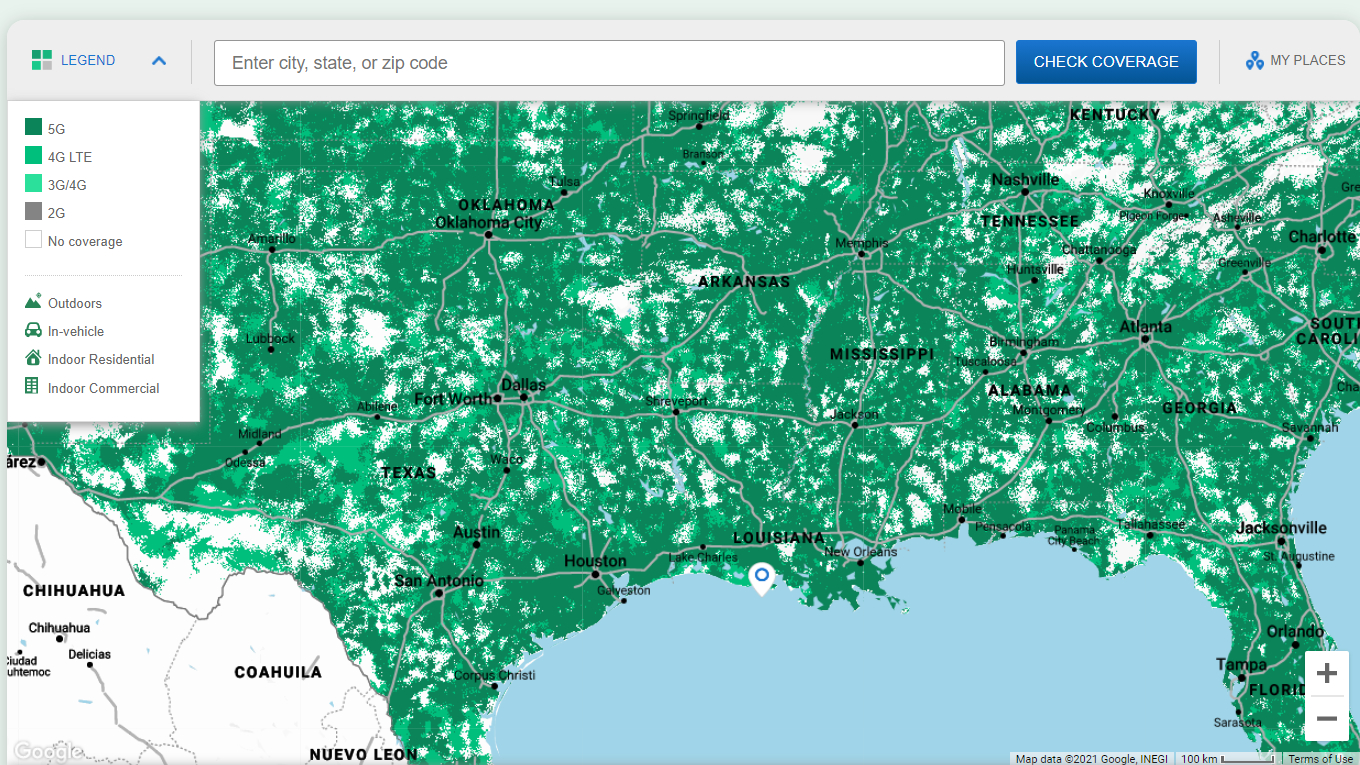
Zoom in on the map and you’ll get a more detailed view of the various types of cell coverage, with 5G (dark green), 4G LTE (mint green), and 3G (bright mint green). Again, they’ve really committed to the mint branding, but it’s clear when you look at it. The map also has coverage breakdowns at specific locations which shows speeds and whether you can expect coverage outdoors, in your vehicle, or indoors at either residential or commercial locations.
You can also enter your state, city, or zip code into the search bar to find out whether you have coverage in that area, which saves you having to navigate the map of the entire country.
Visible
Visible uses Verizon Wireless’s network and as such, offers coverage to over 99% of the US population. You can view the Visible coverage map on its website, but for some bizarre reason it's only available as a small box out, rather than a full page map. You can enter your location into the search bar and the map will zoom to that area though, but if you want to see a wider view then you’re better off just checking the Verizon map we linked to in that section.

Xfinity
Xfinity also uses Verizon Wireless’s network, so you’re looking at the same 99% of the population coverage as the other companies that use this network. Xfinity doesn’t have an interactive map like the others, but there is a ZIP code checker that will let you know if you can get coverage, and whether you can get 5G and/or 4G LTE at that location. If you want to check a wider area to see what coverage is like then you can just use the Verizon interactive coverage map.
Google Fi
Google Fi uses a mixture of T-Mobile and US Cellular’s networks to map up its national coverage. As the coverage page explains, your signal will switch between networks intelligently depending on which offers you the best signal in any given location.
Check out the Google Fi coverage map to check what kind of signal you’ll get in your local area, with both 5G (dark green) and 4G LTE (light green) options shown. You can also enter your address or ZIP code to check the coverage there directly too.

Metro by T-Mobile
The clue is in the name for this one - Metro is owned by T-Mobile and uses its network, so it offers identical cell phone coverage. Metro does still provide its own interactive coverage map though, so you can check to see if you’ll get cell coverage in your area before you sign up to a cell plan with them.
Since it's using T-Mobile’s network, Metro has the same gaps in coverage. There are large areas of the western side of the country that won’t get cell phone coverage using Metro, so check the interactive map if you live in the Western states.
Cricket Wireless
Cricket Wireless is owned and operated by AT&T and uses the extensive network of its parent company. We like Cricket's affordable unlimited data plans, but are disappointed by the speed caps on these unlimited plans - extensive data use could see your speeds plummet down to 3Mbps. Cricket offers an interactive coverage map on its website so that you can check out its service in your area, where the map is split between 5G (dark green), 4G LTE (green), 3rd party coverage (light green), and other coverage (blue).

Since it's using AT&T’s network, Cricket Wireless has the same strengths and weaknesses in their coverage. The eastern side of the US is locked down, but there are some large gaps on the western side of the country in rural and remote areas.
US Mobile
US Mobile is the only cell carrier in our list that doesn’t provide an interactive coverage map on its website. Instead, you can visit this coverage page and type in your ZIP code to find out what kind of service US Mobile can offer you.
We do know that US Mobile doesn’t use its own network though - it provides service using the other major cell networks in America, specifically through T-Mobile and Verizon, so you can expect similar coverage to those networks, albeit without the priority treatment that those networks give their own customers.
So, which cell phone network is best?
Sorry to give the cop-out answer, but it really does depend on where you live and what kind of coverage you require. But with all this information at your fingertips, you should now be able to choose the perfect cell phone provider to suit your needs. Once you’ve got that done, check out our best smartphones or best smartphones for seniors guides to choose the right handset to go with your plan.
Ian Stokes is the Tech Editor here at Top Ten Reviews. He has extensive experience in tech and games journalism, with work published on IGN, Kotaku UK, Waypoint, GamesRadar, Trusted Reviews, and many more. You'll find him covering everything from smartphones and home computers to 3D printers and headphones. He's also our resident cocktail expert.

